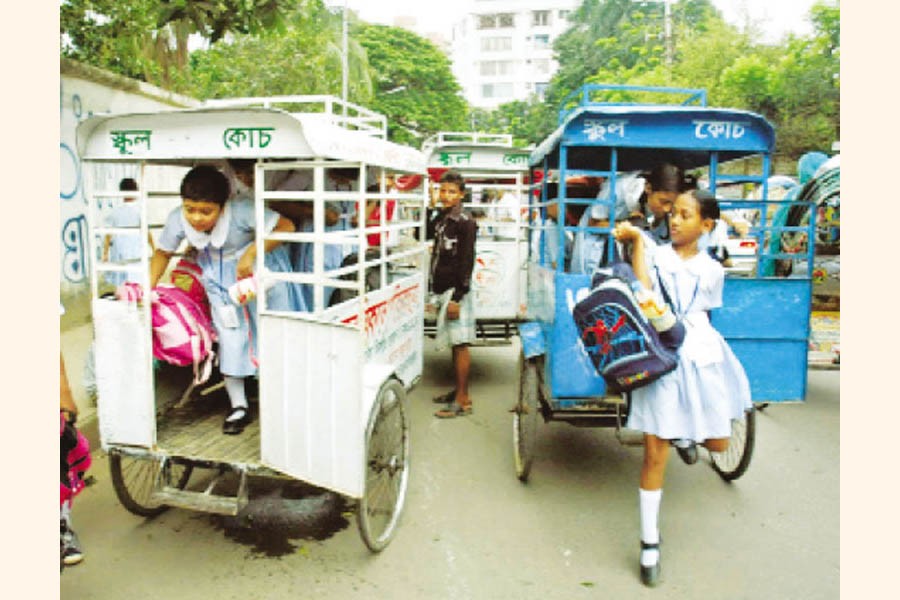Of the many indigenously developed contraptions, a school van is only a type. The rickshaw vans have no roof and enclosure but the school vans have both with bench-like seating arrangement on three sides within. While flat-bed tricycles like 'nasimon', 'karimon', 'votvoti', easy bike, motor-rickshaw etc. have duly been accused of not complying with standard aerodynamics in their body shapes and mechanical engineering for safety, the school vans have never been a target of any such complaint.
Why? Do the school vans follow the standard specification of a transportation vehicle worthy of moving on busy roads in the cities? By the way, do the vehicles have licences to ply on the city roads, the main and busy roads in particular? Usually these cage-like light and vulnerable vehicles move within a locality but that is not always the case? Even in Gulshan and Banani a slew of such school vans can be seen moving on and crossing the main roads around the diplomatic zone.
The flat-bed tricycle vans carry passengers without a roof and side covers on them usually in the country's rural areas where traffic is thin. Even then, it is a dangerous ploy to expose passengers to risks of a possible collision with other vehicles, particularly faster moving motor vehicles. In large cities these are used for carrying goods when pick-up vans prove costlier for small traders. These are also used as makeshift mobile van for hawking a range of goods from vegetables, fruits, fish to apparels. When heavy loads are carried, apart from the puller, there may be an assistant to push the vehicle from behind. Naturally, the distance cannot be long and usually the vehicle keeps to the extreme left because of its slow movement. This itself acts as a safety measure.
From all such points of view, does a school van enjoy an edge over the open van? The answer is both yes or no. Yes, because the vehicle at least has a roof and some protection all around, albeit its fragility. The greatest protection, however, issues from the psychological point of view. Whenever such a van is in sight with small angelic faces peeping from within, drivers of all other vehicles overtaking it or following it from behind become cautious to take as much care as they can to avoid a close call.
However, the crudely constructed roof and the side protection should not provide the aerodynamics that a vehicle needs to have through continuous research and experiment. The fundamental weakness lies in its chassis that is, like that of vans, borrowed from rickshaws. The mechanical device is as good as that of a rickshaw, which is operated by manual power. There is no shock absorption and the seats are very uncomfortable. Children are huddled there together at times like sardines.
Many would shudder to think that parents can rely on these crude and vulnerable vehicles pulled mostly by illiterate people coming from villages. At times they would rather opt for short-cuts, no matter if that means plying on the wrong side or in the opposite direction or even taking a U-turn which is highly dangerous. The only silver lining is the organised operation of these vehicles by some people who monitor the movements of their vehicles. So far, no incidents of missing of children from such vans either on way to school or on way to return home has been reported, let alone taking hostage of a kid for ransom.
Why parents have to resign to such a risky arrangement for transportation of their children to school and back home, is quite understandable. In a chaotic maze of traffic, this is doubly risky. But parents with limited means and schools not providing transports of their own, there is no other option for some parents. If they could they would have opted for personal cars for taking their kids to schools and bringing them back home under personal care. The schools that can afford should make an arrangement for school transports.
Buses and microbuses are presented as a gift to colleges and universities on behalf of the prime minister and some charitable organisations. In fact, the school kids need them most. Their need for such transports is more than the senior students. A pool of better transports than the school vans can be arranged if those are subsidised by the government. A public-private initiative would be most welcome for such an arrangement.

- Monday, 23 December 2024 |
- Today's FE |
- e-Paper |
- Beta Website

